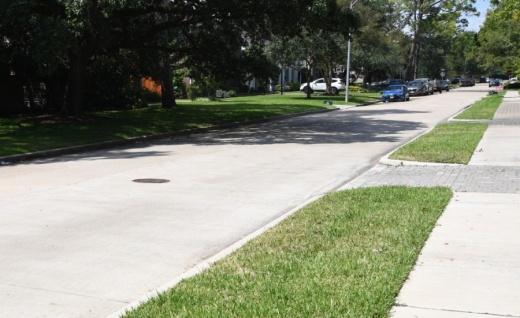Jacobs communicated the frustration felt by some Bellaire residents regarding the city’s process for sidewalk construction across three areas: flooding concerns, transparency from local government, and lack of local control.
“Ladies and gentlemen, we’ll not have this issue coming forth every year with every new overzealous council member,” Jacobs said.
The petition was the culmination of years of debates about sidewalks in Bellaire. Nearly two years later, voters will weigh in this November.
“People felt like they didn’t have a voice,” Jacobs said. “This was an issue where people just need to protect their property, and they need to protect their rights.”
Stepping back
Since he came on to the City Council in the late 1990s, Pat McLaughlin, a longtime Bellaire resident and former City Council member, knows firsthand about the sidewalk controversy.
“Some people have very strong feelings opposed to sidewalks,” McLaughlin said. “Others favor the sidewalks.”
The debate dates back decades to Bellaire’s development post-World War II, when sidewalks were installed in some areas but not others, Mayor Andrew Friedberg said.
“Because Bellaire did not have sidewalks from the very beginning of the city, that’s why it’s the subject of disagreement,” Friedberg said. “Had we had them from the start, nobody would give them a second thought. But because any new sidewalk necessarily involves retrofitting into an existing landscape, it represents change.”
Bellaire’s Comprehensive Plan, adopted in 2015 and amended in 2017, made a continuous sidewalk network a high priority for city elected officials, “even in the face of vocal, localized opposition as particular segments are to be built or improved” while recommending a case-by-case approach for constrained and contentious locations.
However, the $54 million Bonds for Better Bellaire program, approved by voters in November 2016 with $24 million focused on streets, drainage, and sidewalk work, later sparked resident pushback. As a result, around $4 million in potential sidewalk projects was reallocated to drainage work.
“I think at the end of the day, it starts and ends with the way they went about the Bonds for Better Bellaire program and the way they moved to implement it,” Jacobs said. “They could’ve gone out of their way to make sure that people knew their blocks were going to be affected.”
Not long after the bond election, a proposal for a Community Pathways Plan looking to lay out a project agenda for a new sidewalk network prompted further resident concerns.
“Although it was only a very preliminary study, the citizens perceived that the bulldozers were idling and ready to plow through their front yards to implement this connectivity or pathway study,” said McLaughlin, who left office at the end of 2019. “And the citizens were quite irate about it, and that warmed up the citizens for further sidewalk opposition.”
As a result of the pushback, City Council shelved the plan in 2018.
Ballot battle
The petition presented in 2019 put forward three propositions: require the city to provide six months’ notice of potential sidewalk construction along with detailed project implications, require 50% of residents on a block to approve a sidewalk improvement and require the city to mitigate the drainage effects of all sidewalk projects.
Each proposition will be voted on separately, meaning all three, none, or one or two could pass depending on the vote.
Meanwhile, a political action committee pushing back against the propositions said the amendments will make it impossible to build new sidewalks.
“I was deeply shocked when I read these charter amendments,” said Patricia Bernstein, a member of the group, SafeBellaire. “They don’t say in so many words we’re going to ban any new future sidewalks in Bellaire forever, but in effect, that’s what it would accomplish, and that is their purpose.”
If the three propositions are passed, the city would need to hire an independent firm to perform a hydrological study, and then 50% or more people on a particular block would need to express written support in favor of the construction, a significant roadblock in future sidewalk efforts, McLaughlin said.
“The city could engage in that study, spend a bunch of money on each specific block, and then have the citizens reject it,” he said.
Council Member Nathan Wesely, however, disagreed with that notion.
“There are some hoops you need to jump through, but I think if residents want it, those hoops will be easy,” Wesely said.
However there is a bigger issue, Wesely said: the struggle by the city to maintain solid, two-way communication with residents.
“I think the feeling is that people felt they had no input on sidewalks unless they put them in as a charter amendment,” Wesely said.
Ballot guide
Three amendments to Bellaire’s city charter are up for vote in November, each related to sidewalk construction and the notification process by the city to residents who would be affected by such construction. Residents can vote for any of the propositions.
Proposition A— Requires the city to provide six months of notice prior to a City Council action item to construct a sidewalk. The notice would include project schematics and other details, as well as a hydrological study of the proposed project by a third party.
Proposition B—The city may not construct a sidewalk on a residential block without 50% written approval of the property owners on that block no more than three months prior to construction.
Proposition C—The city may not construct a sidewalk unless it also eliminates the impact of the material used in the sidewalk construction on water discharge and runoff in the city.






